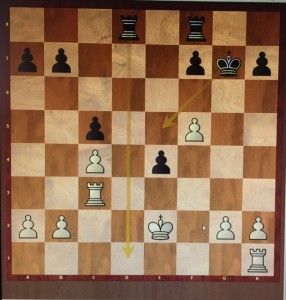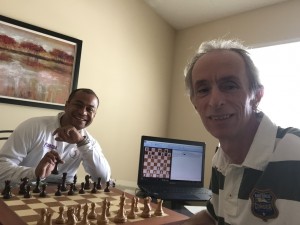Review 1:
Rossolimo and Friends By by Alexei Kornev
The Sicilian defense is the most popular response to 1.e4 for several reasons. First, the pawn structure is unbalanced from the beginning of the game. After 3.d4 cxd4 black gets a central pawn majority duo versus a white pawn on e4. Second, in the open Sicilian white has to take risk to win the game and every move in the opening and middle game are critical. In other words, White has to learn a lot of theory to avoid losing a miniature. Third, the sharp Sicilian middle games from the open Sicilian are a paradox. White may claim a theoretical edge after burning the midnight oil studying theory, but white can no claim that the game is fully under his control. If White lacks a full grip on the actions that means that Black can generate play on his own and create winning chances. Many white players avoid the problems posed by the Sicilian defense by switching to 1.d4. A second group of players sticks with the open Sicilian and use a tactical, sharp approach against the combative Sicilian defense. A third group of players decide to meet the Sicilian half way, with a positional and active repertoire. If you prefer the third approach against the Sicilian defense, please keep reading on.
Alexei Kornev is the author of the book, Rossolimo and Friends. This book is a repertoire book for White against the Sicilian defense and the recommendations have a solid positional foundation. The author databases and his own analysis to illustrate his recommendations. The books is composed with hundreds of game fragments of games in contrast to the complete game format favored by Gawain Jones in his repertoire book versus the Sicilian (2011). The format selected by Kornev to write this book provides the reader with the right mix of old and recent games, more content than the complete game format and more references to continue his own studies. Every chapter ends with a summary. I recommend the reader to read the summary first to get a better idea of what the chapter is about and what are the better lines for White or the lines that are really bad for black. I found Kornev’s explanations clear, concise and to the point, but the reader will need a good positional background to get the best of the book.
I compared Kornev’s book to Gawain Jones’s book on the same topic and came with four relevant differences between the books. First, the formats is different, complete game versus fragments. Second, bibliography is more comprehensive in Kornev’s book because he relies heavily on databases. Finally, Kornev analysis is better in some critical lines. For example, in the game Muzychuk – Giri. Wijk aan Zee 2010 after the moves 1.e4 c5 2. Nf3 d6 3.Bb5+ Nd7 4.d4 cxd4 5. Qxd4 a6 6. Bxd7 Bxd7 7.c4!? Bg4 Jones consider this move a mistake. In contrast Kornev do not condemn the move and explain the ideas behind it. It is worth to mention that in her analysis of this game in Megabase 2013 Muzychuk annotates Bg4 as a novelty! And states that more analysis is need to fully understand the resulting positions after Bg4. The main difference in the annotations between Jones and Kornev are more obvious after the move 8.Nc3 e6. In the variation 8…Bxf3 9.gxf3 e6 10.Be3 Jones wrote “White should have a small edge due to his space advantage” and later continues with “I like the idea of castling long for White hiding the king away on b1. In comparison, Kornev recommends 10. b 3 placing the dark square bishop on b2 and after 10…Be7 11.Bb2 Bf6 12.Qd2+/= (followed by 0-0-0) “Black’s d6 pawn will need protection. Kornev cites the game Castaldo- Palac, Arvier 2012. This highlight the main value of Rossolimo and friends to the reader; the book offers new ideas in relevant positions that are backed by strong computer engines (I founded that 10b3 is the top choice of Komodo 8 depth =24)
Rossolimo and Friends is an advance book suitable for players looking to improve his/her chances against the Sicilian using a solid, positional method.The potential reader needs to be aware that a certain degree of positional knowledge is require to take full advantage of the material in this book. In my opinion an ambitious 1700 player (USCF) has the positional understanding to use Kornev’s book. Chess coaches interested in helping their trainees to expand their repertoires against the Sicilian should consider to get a copy of this book too.
Review 2
Dreev vs the Benoni
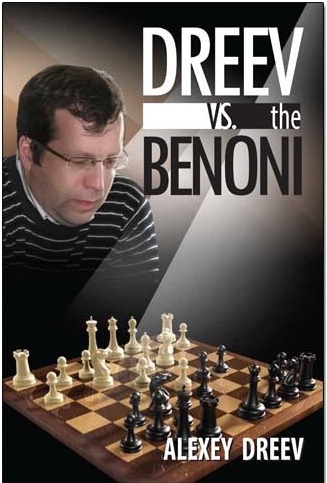
Dreev versus the Benoni by GM Alexey Dreev is an advance, well written chess book. In the past, opening chess books for advance players lacked flexibility regarding target audience. In other words, only very strong players have the tools and experience to use such books and strong amateur were unable to learn from cutting edge manuals. In contrast, In Dreev vs the Benoni and several chess books by Chess Stars I notice an amateur friendly structure. In this book, Dreev delivers high quality content for the master player but also explains in words his choices and philosophy behind the proposed variation. The explanations are not verbose (to bore strong players) but long and to encourage a motivated strong amateur to work on this book. I come with three factors that make this book a good choice for 1.d4 players. First, the author starts explaining the value of move orders in the chosen variation or chapter. Second, the proposed lines are explained and evaluated according to level of control the first player retains in the position. Finally, the strategic goals and evaluation of the resulting positions for each color are outline in a clear manner. For example, how to make or prevent a space advantage from become decisive. Most of the material in this review will be based on Pallister’s books on the black side of the Benoni.
Move orders in the Benoni are a key factor to understand this opening and use this book. In modern practice both players aim to restricts their opponent’s choices from the beginning of the game. A cunning move order can be used to side step dangerous variations, narrow the number of variations to study or just force our opponent into our turf. The first test for Dreev’s recommendation is when black uses a Nimzoindian move order to play the Benoni. The idea behind this move order ploy is to force a white knight to f3 after the moves 1.d4 Nf6 2.c4 e6 if White do not want to play the against the Nimzoindian. This idea (bluff) is very popular below master level to obtain a Benoni without the risk of running into the sharp Mikenas and four pawn attack variations. A well know example of White attacking chances in these f4 lines is the game Kasparov – Nunn, Olympiad 1982. After 1.d4 Nf6 2.c4 e6 Kasparov replied 3.Nc3 without fear to facing the nimzoindian and Nunn played 3…c5 reaching a Modern Benoni. After 4.d5 exd 5.cxd d6 6.e4 g6 7.f4 Bg7 8. Bb5+ Kasparov seized the initiative and won a wonderful game in 21 moves! In his comments after the game Nunn stated” In my view this is one of White’s best lines against the modern Benoni. White secures good attacking chances at little risk for himself” (An opening repertoire for White by Raymond Keene, page 103. Mac Millan 1984). Nunn’s opinion still valid today and was backed by Pallister in his recent book Chess Developments The Modern Benoni page 113 Everyman 2011) “ It may have been caught by the Modern Main Line in the popularity stakes, but the Taimanov Attack remains arguably the critical test for the Modern Benoni. Even since the early 1980’s many Benoni players have sidestepped with a 2…e6 (offering the Nimzoindian in the event of 3.Nc3)”
In the Modern Benoni Black envision an unbalance game with chances for both sides. As pointed out by Psakhis in his book Advanced Chess Tactics (Quality Chess 2011) “It is hard to find any other opening in which we have so many opportunities to show our tactical and aggressive skills”. Dreev recommendations angle the game into positions in which White retains control of the position and prevent Black to obtain a dynamic or unclear game. The goal for White is to obtain a stable positional advantage. For instance after 1.d4 Nf6 2.c4 e6 3…c5 4.d5 exd 5.cxd d6 6.e4 g6. Dreev advocates 7.h3 instead of the natural 7.e4 to reduce Black counter chances.
In Dreev versus the Benoni the author makes a clear distinction when White space advantage is relevant and when it is not. Notably, Dreev emphasize what options for Black are the best response to his suggestions. By way of Illustration, in the main line, the author states that 9…b5 is the test to his chosen recommendation. The question here is what about 9…a6? This move is very popular choice at club level and discussed in Pallister’s Chess Development modern Benoni (CDMB) book previously cited. Dreev devoted chapter seven and eight to 9…a6 and suggests some powerful recommendations ignored in CDMB.
The last part of this review will compare Dreev recommendation versus the Czech Benoni in relation with Pallister’s book How to Play Against 1d4 (2010). In these closed Benoni position is where Dreev’s approaches will caused the more problems to the second player as admitted by Pallister “One problem for both your author and those studying these lines as Black is that White’s move order is very flexible”. For club players this is a valuable asset because without increasing your study workload they can keep the pressure on Black. White just alternates the move against the same opponent without the need to study new variations or plans. White gives Black to go wrong early not having to resort on dubious gambits to generate play against a very solid structure.
In summary, I am happy to recommend this book to players in the 1700 USCF rating and up. Dreev’s presentation of the white side versus the Benoni is super and will last for years to come.
Review 3
Attacking the Caro Kann
The Caro- Kann Defense is the epitope of solidity and realiability in chess. In chess history, several world chess championship matches revolved around White trying to pierce Black’s weakness free fortress. Attacking the Caro Kann by Alexey Dreev is a repertoire book for white against the popular Caro Kann defense. The author recommends the advance variation 1.e4 c6 2.d4 d5 3.e5, to lure Black into less explored territory than the classical main lines and to play creative chess to fight for the initiative.
To understand what Dreev means by “less explored territory than the classical lines in the Caro Kan” we need to remember that the closed nature of the advance variation is less prone to computer analisis than the classical lines. In consequence the second player will be on relying on his own instead of remembering his/her computer preparation. In professional chess circles, taking your opponent out of his home preparation is a major practical goal that increase your winning chances. This anti computer preparation strategy is not new. GM and computer expert Larry Kaufman in his White and Black repertoire book page three on the French and advance Caro Kan (2004) states “In these rather closed openings the computers tend to be of limited value”. This statement highlights one of the values of Dreev’s book. The author explains in words, what is going on in the complex middlegames resulting of the advance variation instead of fleshing computer variations with trivial commentaries.
The book is divided in three parts. Part one covers Black’s 3…c5 option and parts two and three cover 3…Bf5. At the end of the book, the reader will find fourteen annotated games. Dreev plays with the Black pieces in three out of those fourteen games. In my opinion Dreev’s games and notes are very instructive from the technical and practical points of view. For example, Dreev explains the methods to increase a space advantage and how to transform space into an attack. In the same order of ideas, the author shows how to create practical chance to draw in worse (lost) positions by pounding on your opponents subtle inaccuracies. Importantly, Dreev discusses why Black aims to trade Queens in several positions resulting from the advance Caro Kan and how White can keep the fight going and avoid transitioning to an unfavorable endgame. Many Caro Kann players make the endgame their hunting ground so if White avoids playing in his opponent’s turf that is a practical triump.
In summary, this book is aimed to players above 1800 USCF that enjoy a battle in complex and no standard positions. The tactics in this book are not that complicate. In contrast, the technique and methods required to convert an advantage may be taxing for players below 1800. Recommended!
Review 4
The Safest Scandinavian
Opening theory is driven by the games between top players with very little input coming from the chess players competing in open tournaments and weekend Swiss system tournaments. This is not a surprise, because elite players and open tournament players face different type of opponents which in turn affect the opening choices they make. For example, a strong player in the open circuit may deviate early from opening theory against weak opponent to use his/her superior skills in the midlegame or endgame. The same approach will be an epic failure at elite level because if a player does not get an advantage out of the opening his peer will find a safe way to equalize the game. In other words opening evolution takes place at a higher rate in Elite tournaments than in the open circuit. The only exception to the last argument is the evolution of the Scandinavian 3…Qd6 that was fueled mainly from games played by Sergey Tiviakov in open tournaments. Now the Scandinavian 3…Qd6 is played at the highest levels of chess like in the game Andreikitin,D (2722) – Caruana, F (2844) FIDE Grand Prix 2014.The most recent an comprehensive book on the Scandinavian 3…Qd6 is The Safest Scandinavian by GM Vassilios kotronias. In the next paragraphs I am going to review the more relevant features of this book.
The Safest Scandinavian is an opening repertoire aimed to professional and amateur players that combines solidity with asymmetric pawn structures that guarantees a complex middlegame battle. In the author’s own words his first impression about the Scandinavian Qd6 was that this variation resembles the fight of God (classic play) with His antagonist (anything, but classic play). The reader will see how Kotronias uses this battle classic versus non classic as a driving force to recommend options to black and give it to the text a philosophical flavor. Finally, the author makes a significant effort to discuss and explains his recommendations in the context of human logic and warns the reader on the dangers of excessive (abusive?) computer use.
Repertoire books against 1.e4 always reflect the way the author “feels” about the opening and chess as a whole. In The Safest Scandinavian, Kotronias’s recommendations for Black are dynamic in most situations, but without sacrificing energy unnecessarily. For instance, against the Blackmar- Diemer gambit, the author suggests to reach a position in which blacks aims to restrain white pieces instead of fighting the gambit in a blow by blow fashion. Black avoids entering into white’s turf because the risk is too high and the reward is low. More importantly, the author saves space to discuss more important aspects of the middlegame and endgame related to the 3…Qd6 Scandinavian. The author avoids to annotate the endgames that are a clear draw, this may be a little taxing on amateurs with a shaking technique in the endgame, but in general the thirty seven model games in The Safest Scandinavian are well annotated. I like that Kotronias does not shy to express his opinion about a particular position even if this goes against the choices of leading experts in the 3…Qd6 Scandinavian such as Sergey Tiviakov. For example, against Shirov’s plan with 7.f4 after the sequence 1.e4 d5 2.exd Qxd5 3.Nc3 Qd6 4.d4 Nf6 5.Nf3 c6 6.Ne5 Nbd7.7.f4 Nb6 8.g4 Nbd5. Kotronias criticize the spending 3 moves out of 8 moving the same knight.
The annotations in this book combine variations, verbal explanation with a high level of knowledge of typical positions arising from the 3…Qd6 Scandinavian. As a chess trainer I value the step by step introduction (characteristic of the Chess Stars books) before delving into the specifics of a variation.For example in the game 25 Slobodjan- Muse Bundesliga 2006, Kotronias, explains that 12…Nb6 (see picture) is not good because black needs to counter white active play in the center challenging the knight on e5 and preparing the c6-c5 break.
The author consistently analyses and explains the middlegame positions in the context of the key strategic features of the position instead of a string of computer generated variations. In my opinion, Kotronias’s annotation style helps the reader to develop a sense for what moves/ideas he/she should be looking in middlegames arising from the Qd6 Scandinavian. Amateur players will benefit the most from the way the ideas are discussed and explained in this book. Returning to the game Slobodjan- Muse Bundesliga 2006, 12…Nb6 is not a major blunder in the sense of losing material, but as Kotronias demonstrates black cannot fight better because he has lost the tread of the position. Later, the game ended after white sacrifices his knight on e5 (which creates multiples threat against the black king) creating a devastating kingside attack (see picture).
Black decided to use the pawn push b5 instead of challenging white in the center with c5 and the game become a one way affair.
In summary, the Safest Scandinavian is a reliable opening repertoire based on the Qd6 Scandinavian. Kotronias put together more than a repertoire book against 1.e4. In The Safest Scandinavian the author corrects faulty analysis in some variations, suggest several novelties, explains how to play the middlegame with a balanced opinion, and more importantly, show how to use your brain instead of following a chess engine.The last statement is important for the chess player that want to take back his/her chess from blindly following computer assisted analysis.Highly recommended!
Review 5
Attacking The English/Reti

Attacking The English/Reti is the new repertoire effort by Alexander Delchev and Semko Semkov against the English and Reti. The repertoire is designed around 1…e5, follows a classic approach (occupation of the center with pawns), provide novel analysis and aims to improve on the work of Mihail Marin and John Watson.The book aims to advance players, but the content and format are friendly with players below master level. As usual, the duo Semkov- Delchev, provides the reader with a brief introduction to the historical evolution of the recommended lines.
The historical background of a variation helps the audience to expand his/her chess culture which is not trivial matter in chess progress, because if you know how a variation evolved, who was the leading expert you can direct your selt study efforts in the right direction and acquire information faster. For example,Delchev and Semko explain that the tactical fundation of the variation 1.c4 e5 2.g3 Nf6 3.Bg2 c6 4.Nc3 d5 in the context of the game Petersons- Tal, Riga 1958.Now, it is clear to me that Tal is the role model in this variation to follow.Later, it was easy to me to track down the steam game Benko- Tal 1957. Importantly, this game is explained by Jeremy Silman and Pal Benko himself in the book My life, games and compositions (page 151 and 452). Benko and Silman’s book has additional information on the 1.c4 e5 2.g3 Nf6 3.Bg2 c6 variation that will help the ambitious chess player to understand clearer the developments in the English with 1…e5 in the 70’s.
Attacking The English/Reti advocates the use of central control with pawn against the English with pawns on d5-e4. In contrast to the isolated queen pawn(IQP) structures favored in this variation. I think this is the right choice, because players under 2000 can understand the resulting middlegames positions with the d5-e4 duo better, than middlegames with an IQP. For instance, after 1.g3 e5 2.c4 Nf6 3.Bg2 c6 4.d4 exd4 5.Qd4 d5, the games, Markowski,T (2568)- Krasenko,M (2702) , 0-1 and Suba, M (2445) – Huebner,R (2610), 0-1 show how complex this type of IQP positions are and the level of mastery black needs to display to win.
Delchev and Semkov provide novel analysis as one of the corner stone of the repertoire book (second alternatives to black is the other hall mark of this book). The authors successfully improve the analysis over some lines championed by M,Marin and Watson,J. This prove the amount of work and novelty the repertoire packs. On my end as a reviewer, I found that Attacking The English/Reti, Improves the analysys of two book widely used by club players on the white side of the English/Reti, named, Guide to the English Opening 1…e5 by Carsten Hansen and the Dynamic English by Tony Kosten. In the later book, the author states that the main problem for black after 1.c4 e5 2.g3 Nf6 3.Bg2 c6 4.d4 e4 ” This advance is playable,if not at all popular. The main problem with Black playing such structures (a reverse French) is not only that that White has an extra tempo,but also that he can develop his queen’s bishop outside the pawn chain”. Semkov and delchev demonstrates that Kosten’s evaluation of the position is not accurate and black has a lot of scope to play actively. Attacking The English/Reti is recommended without reservations.
Review 6
The Spanish Main road
The Spanish Main Road is a well written repertoire book for black by Grand master Evgeniy Solozhenkin. In this effort, the author offers a novel repertoire for black with the Zaitsev variation as the corner stone of the book. The author has a great deal of experience in the Spanish because he incorporated the Zaitsev system as part of his opening repertoire when he was a master candidate The main contributions from the author to the reader are the way the material is presented, the crafty way the theoretical content is connected with the historic development of each variation and the original contribution in the assessment of many variations.
The Spanish is a complex and heavily study opening that poses a challenge to most amateur players and even professionals. Some players never venture to enter the “Spanish maze” and prefer to play a side line after the sequence 1.e4 e5 2.Nf3 Nc6 3.Bb5. For example, the Cozio variation (3…Nge7, the Schliemann 3…f5 among other options for black. Solozhenkin uses his extensive experience as a coach and player to lay out a “road map” to facilitate to the reader the understanding of the Spanish opening as a whole. Solozhenkin helps the reader to navigate the ‘Spanish Maze’ and to arrive to the Zaitsev system in a systematic fashion.
The book starts after the sequence 1.e4 e5 2.Nf3 Nc6 3.Bb5 a6 up to Zaitsev variation at move nine (4.Ba4 Nf6 5.0-0 Be7 6.Re1 b5 7.Bb3 d6 8.c3 0-0 9 h3 Bb7. Previous books on the Zaitsev system such as the closed Spanish by Anatoly Bikhovsky (1993) start the discussion of the variation from move nine which let most amateur players wondering what to do against white sidelines like the dreaded exchange variation or less critical but popular systems such as the Wormald and Worrall attacks. Emm’s book Easy guide to the Ruy Lopez (1999) is more comprehensive than Bikhovsky’s book but after a41.e4 e5 2.Nf3 Nc6 3.Bb5 a6 up to Zaitsev variation at move nine (4.Ba4 Nf6 5.0-0 Be7 6.Re1 b5 7.Bb3 d6 8.c3 0-0 9 h3 Bb7 10.d4 Re8 11.Nbd2 Bf8 only cover the moves 12.d5 and 12 a4. In contrast, Solozhenkin explains with words and variations how black needs to play against 12.Nf1, 12.Ng5, 12.Bc2 and 12.a3.
Each variation starts identifying who deserves to be the credited with the authorship of that particular idea or who is the main practitioner. Next, the author explain what is the idea behind a move, particularly, the connection between pawn structure and piece play. Finally, the author reevaluates previous analysis and adds new examples to illustrate key positions. Importantly, the author motivates the reader to dig deeper and found new resources. For example, after understanding the main ideas behind the Zaitsev system I was able to use my computer to find couple of interesting and novel ideas. This book is recommended if you want to play the Zaitzev or if you are a chess trainer like me and desires to understand the evolution of the Spanish as a forefront opening in chess.
Review 7 Attacking the Flexible Sicilian
Vassilios Kotronias and Semko Semkov
The Sicilian defense is a complex opening to face as white for two reasons (in my opinion) First, opening theory travel fast and changes at an equal pace and e4 players need to keep up with that full time job, even to beat significant lower opposition. Second, after the e4 player has everything under control, his opponents switch to “flexible Sicilians and kwon on top of theory the first player has to be on his toes on cunning move orders and transposition. In this days of computer preparation and the internet, a new development in the Sicilian is share and analyzed all over the world and any amateur can have access to high quality GM class analysis .In consequence, an e4 player has the daunting task of beating weaker opponents that come to the board armed with the latest theory on the Open Sicilian as black. To make things worse for white, black players are transitioning from 2…d6 Sicilians like the Najdorf or Dragon to 2…e6 Sicilians, here in Florida, two of our young players, John Ludwig and Dalton Perrine made this transition from d6 to e6 Sicilian with excellent results. The reason is simple at 2200 level a d6 Sicilian is a good option, but “after you break 2300 you will face stronger opposition and the e6 Sicilian are a good choice because its flexibility “(personal communication with John L). So what are White’s best response against this myriad of Flexible Sicilians like the Taimanov, Kan, Pin and even the transposition to the Sveshnikov from a 2…e6 Sicilian ? White has several options, including burning the midnight oil trying to single handed attempt to refute black ideas (with computer assistance) or to buy the book Attacking the Flexible Sicilian, by Vassilios Kotronias and Semko Semkov.
If you are considering to buy a book Attacking the Flexible Sicilian here are my findings as I checked some of the author’s recommendations against master praxis in the following variations, Taimanov, Anti Sveshnikov, and the Kan. The chapters on the Kan are especially instructive. In general, the explanations of move orders and transposition will help the ambitious improving player to navigate the Sicilian Labyrinth better.
Taimanov
After the move sequence, 1.e4 c5 2.Nf3 e6 3. d4 cxd4 4. Nxd4 Nc6 5.Nc3 Qc7 6.Be3 a6 7.Qf3 Nf6 8.0-0-0 the authors explained the current theoretical status of several of black alternatives, but highlighted 8…Nxd4 9.Bxd4 e5 10. Be3 d6 as the more likely future battleground of the whole variation (see picture for a snapshot of the position)
Kotronias and Semkov proceed to explain to the reader why their recommendation is better (something that the live book of Chessbase confirms) than the move 11.h3 recommended by the chess engines “The other option to 11.h3 might ultimately lead to the same confrontation of opposite color bishops…The difference between the two positions is that in the latter the d- file is open and it gives Black counter play although the engines prefer it”. When you look at the database, 11.h3 is indeed more popular (players following the engine recommendation), but white’s score is not impressive. In contrast, after looking at the authors recommendations White score’s is very impressive, five wins and two draws! Out of seven games. The sample game is small because the move is just becoming popular. Importantly, after 11.h3 the result between two players above 2500 can go either way, but after the author’s recommendation, black players of 2500 caliber and up fail to score a win.
Anti Sveshnikov
The Sicilian Sveshnikov was the rage in the late 90’s and early millennium, the chess elite play it on a regular basis and the theory of the whole variation increased exponentially. In consequence, white and black players are require to come to the board fully prepared theoretically, and rating difference (at least in the opening phase of a game) became secondary. It is worth to put the recommendation in+++++ in the context of the amount of work to play white at a competitive event. For example the game Yanovsky, Vlad (2165) vs Zimmer, R (2268) from the ICC USCL (week8) 14.10.2014, published in the Florida Chess Association magazine, spring 2015, page 11 with annotations by Yanovsky. 1e4 c5 2.Nf3 e6 3.d4 cxd4 4.Nxd4 Nf6” I knew he played this line when I prepared for him. I am not a fan of it, 5.Nc3 Nc6 6.Ndb5 (see picture)
this is the critical move to prevent black from having (note-original text ends here) Bb4, a lot of people play this but I do not understand why? [6…d6 7.Bf4 e5 8.Bg5 transposing to the Sveshnikov.] 7. a3 Bxc3+ 8.Nxc3 d5 9. exd5, black gets the isolated pawn and it is considered equal, but I prefer White 10. Bd3 0-0 11.0-0 d4 12 Ne2 Bg4 13.f3 Bh5 14.Bg5 it was at this point I am out of my prep (1-0, in 55). In other words to play this way white needs to know how to play against the proper Sveshnikov and the Sicilian four knights. In Attacking the Flexible Sicilian, the authors recommend 6.Nxc6 and make a good job explaining the ins and outs of this alternative that negates Black typical counter play along the c file and helps white to actively fight for the control of the dark squares.
Kan Variation
The part of the book covering the Sicilian Kan is very instructive because the explanations in the background of high level chess games allows to bring up to speed the reader regarding the historical development of the variation. The authors also compare their analysis to the recommendations in previous book on the Kan such a Play the Sicilian Kan by Hellsten. All the major alternative to both colors are discussed, critical examples are explained, and even an alternative repertoire in the 1e4 c5 2.Nf3 e6 3.d4 cxd4 4.Nxd4 a6 5.c4 Nf6 6. Nc3 Bb4 is provided (based on Bd3, instead of Qd3 as Carlsen played in the 2014 Wch Match against anand). The authors are passionate about theirs recommendations especially against the 6…Qc7 Kan. To face the queen sortie a crushing attack is suggested instead of typical Hedgehog approaches with a3 and f3.
In summary, this book has first, a lot of novelties generate by humans, instead of endless variations. Second, this effort contains a massive amount of high quality and easy to read material. Finally, all novel ideas suggested by the authors that are designed to take the fight to black and force him/her to play on his own and not just “play for free” following the moves of tops GM’s. Highly recommended!
Review 8
A Practical Black Repertoire with Nf6, g6, d6 Volume 1 and 2
By Alexei Kornev
Couple of years ago Alexei Kornev wrote a three volume opening repertoire for white after 1.d4 and 2.c4 and now the same author offers a similar effort to players with black, A Practical Black Repertoire with Nf6, g6, d6 Volume 1 and 2. The main characteristics of this repertoire for black are clarity in explaining the resulting middle game and endgame position resulting from the opening, subtle move orders and transposition, flexibility and innovation. The author divided the repertoire in two books, volume one deals with all white options other than 1.d4 and 1.e4. The cornerstone of this volume is the Pirc Defense for black. Volume two covers the Kings Indian Defense. Kornev’s choices aim at generate winning chances with the black pieces. Importantly, the author’s selection of the Pirc against 1.e4 reflects current opening preferences of professionals and amateurs when looking to win with black. Ten year ago, the Pirc was popular at club level, but not at elite level as explained by James Vigus in his book The Pirc in Black and White (2007). Vigus explained that at the beginning of the millennia the elite was press no to lose with black and the Pirc was a risky opening. In contrast, today, the chess elite is willing to take risk in order to win with black in the super tournaments a recent example is the game
The author uses a common piece deployment against all white main openings , name Nf6, g6 and d6. In other words, this repertoire advocates a dark square strategy for black with a fianchetto on g7 and an early development of the kingside knight. Since black develops his pieces to the same key squares it is easy to the reader to grasp the main tactics and strategic themes related to the Pirc and the Kings Indian, such as the role of the dark square bishop on g7, the need to fight actively for the center out of the opening, the collide between white space advantage and black’s dynamic potential. It is worth to mention that Kornev also explains how black can turn an equal middle game or endgame position into a favorable position to black. Let’s take the following popular position at club level arising from the moves, 1.e4 d6 2.d4 Nf6 3.Nc3 g6 4.f3 Bg7 5.Be3 c6 6.Qd2 b5 (page 278 Volume 1)
“There has arisen a position like in the variation with 11.Bd3, but with the difference that white has already played g2-g4. This circumstance favor black, because after 15…g5, he fixes the enemy pawn on a square of the same color as his bishop. If black succeeds in trading the queens, then he will have a clear advantage in the endgame, because white bishop will be bad.
The second volume of Practical Black Repertoire deals with the King Indian Defense (KID) after the following move sequence 1.d4 Nf6 2.c4. Importantly, side lines like 1.d4 Nf6 2.Bg5 are found in volume 1. In other words if you want to work only on the KID you need to get volume 1 too. The quality of the analysis is great as and follows on the footsteps of volume 1 regarding unity, innovation, and completeness. The book is well organized and easy to read even without a board thanks to the diagrams. The annotations are also clear and illuminating as the author explains move orders and how to play and evaluate the resulting middle game and endgame position in each chapter.
The author does a great job outlining and covering all the sidelines after 1.d4 Nf6 2.c4 g6 such as 3.d5 and 3.f3, the latest move have been in the spotlight of chess praxis thanks to the efforts of Svetushkin and Kaufman. Of course if white decides to play the Saemish variation against the KID Kornev provides the reader plenty of good material and explanation to face it this popular variation. The evaluation of some innovation goes as deep as the endgame. For instance, chapter eleven on the four pawns attack against the KID after reaching the position in the picture
Kornev suggest 13…Nc5 as an improvent on the game Hort- Vladimirov, Moscow 1963, in which black opted for 13…Rc8. As the author explains his innovation the position of the next picture is reached.
At this point, Kornev evaluates the endgame as equal, but outlines the best course of action to black in case white become astray. Black put the king on e5 and double rooks on the d file. This type of explanations are useful to any player as his/her endgame armory incorporate new weapons. In a similar fashion, in chapter theerteen, on the Saemish, the author explains that after 5.f3 0-0 6.Bd3 is inaccurate thanks to the move c5 that forces white to play d5 and free the e5 square for the black knight via d7-e5 like in the game Petrossian- Suetin , Moscow 1953. Kornev explains that in the resulting position black’s bishop pair compensates for the lack of space.
I spent sometime going over this repertoire book and use it in a thematic match blitz match with my friend David Socko from Brazil (2300+ ELO and former member of Enrique Mecking team). After going over this book I was able to find one novelty and surprise my high rated and more knowledge opponent (David won the match and also come with couple of TN as well …). In other words, this book provides solid material to an ambitious amateur player to play the KID and the Pirc with confidence and to improve on current opening theory.
Recommended!

![rossolimo[1]](http://gainesvillechesstraining.com/wp-content/uploads/2015/08/rossolimo1.jpg)
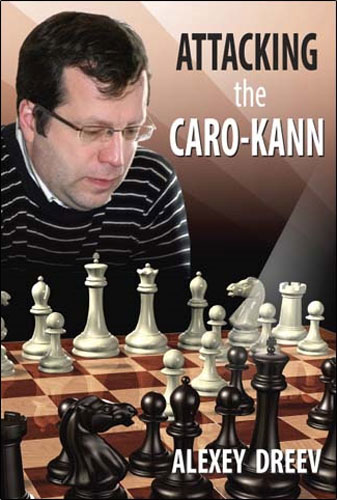



![TheSpanish[1]](http://gainesvillechesstraining.com/wp-content/uploads/2015/08/TheSpanish1-200x300.jpg)
![Attacking_the_Flexible_Sicilian[1]](http://gainesvillechesstraining.com/wp-content/uploads/2015/08/Attacking_the_Flexible_Sicilian1-202x300.jpg)
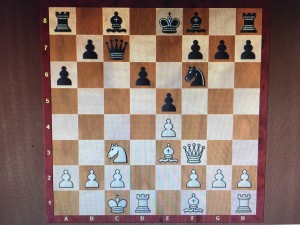
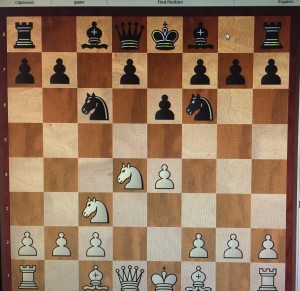
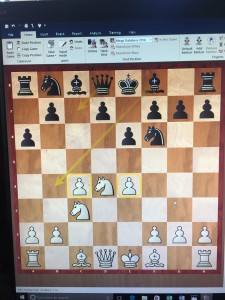
![kornev1a[1]](http://gainesvillechesstraining.com/wp-content/uploads/2015/08/kornev1a1-200x300.jpg)

![practical-black[1]](http://gainesvillechesstraining.com/wp-content/uploads/2015/08/practical-black1-202x300.jpg)

